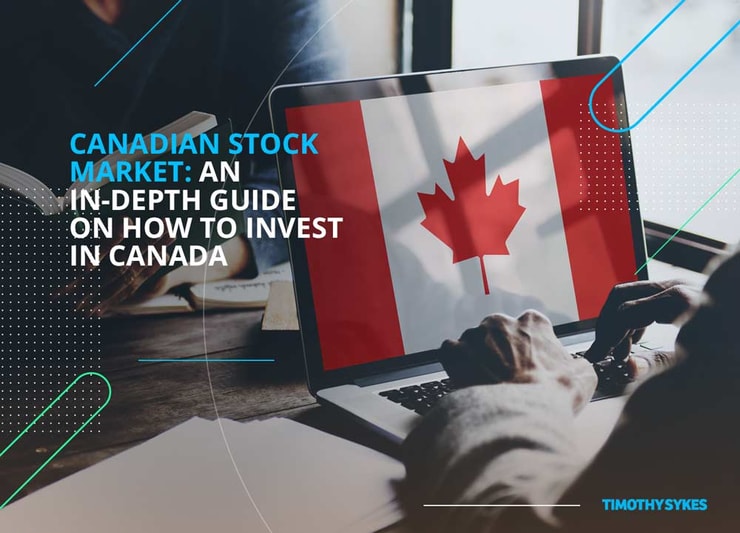When you think of Canada, what do you think of? Hockey, poutine, free healthcare, South Park songs? Well, it’s time to expand your worldview …
If you’re looking for an accessible way to diversify and give your portfolio an international element, you may want to consider investing in the Canadian stock market.
As it turns out, our neighbor to the north offers plenty of investment opportunities for traders from the U.S., from commodities galore to a chance to take advantage of the super-hot marijuana stocks and marijuana penny stocks on the market.
But how can you get started in the Canadian stock market, and what do you need to know before you start investing?
This comprehensive primer on can help get you up to speed.
Table of Contents
What is the Canadian Stock Market?

The Canadian stock market is composed of one large exchange and several small exchanges.
The main exchange is the Toronto Stock Exchange (usually shortened to TSX). The TSX is the ninth largest exchange in the world.
The TSX also has a smaller exchange associated with it called the TSX Venture Exchange (this one’s called the TSX-V). This is where you’ll find lower-priced stocks offered from up-and-coming or smaller companies.
There are other exchanges, but the aforementioned two are the key exchanges, so we’ll mostly focus on the TSX and the TSX Venture Exchanges in this post.
Toronto Stock Exchange and The TMX Group
The Toronto Stock Exchange is owned by the TMX Group Limited. TMX is a financial services company headquartered in Canada that operates derivatives, equities, fixed income, and energy market exchanges.
The TSX exchange includes a wide range of Canadian businesses. Its listings include stocks, ETFs, income trusts, and investment funds.
Why is the group called TMX? A merger. In 2009, TSX joined with the Montreal Stock Exchange, and the parent company’s name changed as a reflection.
Differences Between Investing in the U.S. vs Canadian Stock Market
It might be tempting to think that the Canadian stock market is pretty much the same as the U.S. stock market, just located a little further north. Sorry, but not quite.
While Canada is located close to the U.S., it’s a different country, so we’re dealing with some different things than what we’re used to in the American market. As such, there are some important differences between the stock markets in both countries.
Size: The Canadian Stock market is much smaller than the U.S. exchanges, so there are significantly fewer stocks to choose from overall.
Currency: This might seem painfully obvious, but it’s worth noting. The Canadian stock market is traded in Canadian dollars, not U.S. dollars.
Right now, one U.S. dollar equals $1.30 in Canadian dollars. This can fluctuate, of course, based on various factors. But don’t get confused: the dollars listed on the exchange are not U.S. dollars.
Types of stocks. Canada’s economy relies heavily on natural resources, and that is reflected in the market.
Between the TSX and the TSX Venture Exchange, there are over 3,000 companies. The Canadian exchanges have more mining, oil, and gas-related companies listed than any other stock exchange in the world.
Different laws. There is a different government in Canada, and therefore there are different laws. This can make for some big differences in the market.
For example, the recent legalization of recreational marijuana in Canada means that there is an entire sector of related stocks available that you won’t have access to in the United States.
Benefits of Investing in Canadian Stock Market
The Canadian stock market isn’t just for Canadians. Obviously, Canadians will invest here for simplicity and proximity, but there can be advantages for U.S. (and international) investors, too.
Here are some of the benefits of investing in the Canadian stock market:
A commodity buyer’s dream: Canada’s economy has a strong core of stocks related to natural resources like oil and gas, and it’s one of the largest exporters of minerals in the world.
Canada is also the largest supplier of something called potash, which is used to make fertilizer and important in the world of agriculture.
Yes, commodities can be volatile, but they can offer growth opportunities, too. And with many commodities, you can invest intelligently if you consider reliable patterns like the seasonal aspect of these stocks.
A strong economy: Canada’s banking system is largely considered safe and sound. The banks have great balance sheets and are considered strong.
This positive financial position means that the lending rates are lower than in many other countries. This has far-reaching positive effects in real estate and in retail sectors.
Different currency: Trading in a different currency can actually be a way to protect your U.S. dollars. If the U.S. dollar loses value, this may not rock foreign markets as hard as, say, the NASDAQ.
In this way, by purchasing Canadian stocks, you are, in a way, potentially protecting your investments in case the U.S. dollar decreases in value. There are actually opportunities where you can stand to profit in foreign markets because of the U.S. dollar losing value.
How to Invest in the Canadian Stock Market

Looking to get started in the Canadian stock market? Here are some things you need to know.
Where there’s a will there’s a way. So, you have a will to invest in the Canadian stock market … what is the way?
As an investor, you have a few different options for investing in the Canadian stock exchange.
Purchase stocks through a licensed broker. There are plenty of brokers who are licensed with the TSX. You can place orders directly with your broker. Be sure to check about fees associated with foreign investments, though — they can sneak up on you.
Purchase ETFs. You can purchase Canadian stocks and bonds via exchange-traded funds (ETFs), which are securities that track an index or a variety of assets like an index fund. They’re kind of like mutual funds, but they are traded like stocks and listed on stock exchanges.
Seek out American Depository Receipts. An American Depository Receipt is a way of purchasing stocks from other exchanges through the U.S. market. ADRs are securities that allow foreign companies to trade on the U.S. financial exchanges. Learn more about them in this post.
What Time Does the Canadian Stock Market Open?
At least this part is easy to remember. The TSX and the TSX Venture Exchange operate the same hours as the major U.S. markets: 9:30 a.m. to 4:00 p.m. Eastern time, Monday through Friday.
The Canadian market has an extended session, too. It’s not quite as robust as the pre-and-post-market trading hours offered in the U.S., but runs from 4:15–5:00 p.m. on trading days.
The market is closed Saturday, Sunday, and on major holidays. It’s worth noting that the Canadian market holidays are not always the same as the U.S. holidays, since, you know, it’s not the USA.
Canadian Financial Market Trends
In general, Canada is considered to have a pretty safe economy. It has strong industries, and its monetary policy is stable, and it has a fairly low deficit.
However, like any other market, it is subject to trends and other factors.
For instance, the Canadian market relies heavily on commodities. There can be definite seasonal aspects to commodities like oil and gas, which can set the tone of the market.
There’s a pretty high level of volatility involved with commodities, and since the Canadian financial markets have tons of these types of stocks, the market can at times be similarly volatile.
Policy can have a big effect, too. For instance, one of the biggest market-shaping trends in recent months has been the much-talked-about legalization of marijuana in the country. While the law won’t take effect until October, it’s already causing big waves in the market.
Top Canadian Companies for Investing in the Canadian Stock Exchange

What companies should you consider trading on the Canadian stock exchange?
Like the U.S. exchanges, there are plenty of choices for stocks to trade. However, the market is set up a little bit different than in the U.S., so here are some things to consider when choosing stocks.
How Many Companies Are Listed on the TSX Stock List?
Over 1,500 companies are listed on the TSX, and about 2,000 more on the TSX Venture Exchange.
The TSX is the major and main exchange and includes bigger companies like the Canadian National Railway, Suncor Energy (which is the largest energy company in Canada), and Royal Bank of Canada (which is not only the largest bank in Canada but the twelfth-largest bank in the world).
The TSX Venture Exchange has a lot of smaller companies. This is where you’ll find the up-and-coming companies, and also the ones that probably won’t make it. This means that this is the exchange to look at for the equivalent of penny stocks.
Get to Know What Indices Matter for Canadian Stocks
FYI, the plural form of index is indices.
If you want to keep track of the movers and shakers in the Canadian stock market, you’ll want to look at the S&P/TSX Composite Index.
This keeps track of the value of some of the biggest stocks on the market, which can account for 70 percent or more of the exchange’s total volume.
The index is made up of 11 different categories: financial, energy, materials, industrial, consumer discretionary, telecommunication services, healthcare, consumer staples, utilities, information technology, and real estates.
The first two categories, financial and energy, are the biggest ones by far, with materials and industrial coming in after. That means that these industries really shape how the market is performing, and the economy or commodity price changes can have a pretty big impact.
In terms of the TSX-V, there’s another index to look at: the TSX Venture 50.
According to the TSX website, “The 2018 Venture 50 is a ranking of top performers on TSX Venture Exchange over the last year. The ranking is comprised of 10 companies from each of five industry sectors, selected based on three equally weighted criteria: market capitalization growth, share price appreciation, and trading volume amount.”
The weight of each of the index securities is determined through something called float-adjusted market capitalization. First, the market cap is determined by using the market-cap ratio. Then, restricted shares (such as those owned by publicly held companies, or executives) are taken out of the amount.
The S&P/TSX Composite Index is updated and reviewed each quarter. These are the times when companies might be added or removed from the index.
For eligibility, a security needs to meet certain criteria. For one, it needs to be incorporated, formed, or established in Canada and the TSX has to be the primary place it’s listed. It also must have been part of the TSX for at least six months to be considered.
But wait, there’s more. The company needs to represent a weight of at least 0.05 percent of the index. It also needs to have maintained an amount over 1 dollar (Canadian), as its a volume-weighted average price for the past three months and for the three days of trading prior to the month’s end before the review.
Liquidity is also measured by dividing the number of shares traded during the past year by the float-adjusted outstanding shares. It needs to be at least 0.5.
Securities are subject to removal from the index if these criteria are not met, but they can also be removed at the index committee’s discretion, too.
Indices from the U.S. Aren’t Always Comparable with Canada
An index in Canada isn’t the same as in the U.S. Be sure to check how the index is calculated to gain the best information on the stocks in question.
For instance, in the US, the S&P 500 index is what’s called market weighted. This means that the stocks are shown on the index based on their market cap.
A stock in Canada might not be calculated using the same method, so you wouldn’t get the same information from the listing.
Penny Stocks in Canada
Yep, there are penny stocks in Canada, too.
Penny stocks in Canada are the stocks which are traded on the TSX-V for anywhere from pennies to as much as $5 per share. Unlike in the U.S., they’re not listed on separate pink sheets, but rather on a sort of spinoff of the main exchange.
However, other than that fact, generally penny stocks can be approached in similar ways in Canada as they can in the USA. Once again, you’ll want to distill it down to a repeatable process of scanning for stocks, recognizing patterns, and taking advantages of dips and spikes to hopefully gain profits.
Unfortunately, penny stocks in Canada, like those in the U.S., are not as highly regulated and fraud can (and does) occur. So it’s always important, even in Canada, to research a potential play before you pull the trigger.
Canadian Marijuana Stocks
Soon, recreational marijuana will officially become legal in Canada. According to Forbes, “The Cannabis Act, passed by the Canadian Senate on June 21, controls and regulates the growth, distribution and sale of recreational marijuana in Canada. Prime Minister Justin Trudeau expects everything to be in place for consumption to begin on October 17. “
As you might imagine, this is a huge news catalyst that’s affecting the stock market. It’s spawned a number of enterprises and investments.
As CNN Money reports, cannabis stocks have been sky-high since the makers of Corona beer invested a whopping $4 billion in a Canadian cannabis company called Canopy Growth. The idea is that the company may introduce cannabis-based beverages and other items. This announcement caused a 30 percent surge in the latter stock.
Obviously, this has spawned a lot of interest in other cannabis-related stocks. Several other tickers have seen huge surges, including 40-60 percent growth for some stocks in the past few weeks.
This is a phenomenon that is specific to the Canadian market because, as of yet, marijuana is still not legal in the entire U.S.
With recreational marijuana sales about to become legal in Canada, the stocks are on fire, and this is an advantage that simply can’t be enjoyed in the U.S. markets. They’re selling like potcakes — um, hotcakes — and this trend probably won’t die down any time soon.
What are the Risks of Investing in the Canadian Stock Market?

There are still risks involved in the Canadian stock market. Here are some specific considerations to keep in mind:
The U.S. still matters. Sorry, but if the U.S. markets are in a slump, you can’t simply go north of the border and trade up a storm without consequence.
Per the U.S. Census Bureau, the USA is Canada’s biggest trading partner. As such, both countries’ economies are linked, and the general tone of each market will affect the other.
Less diversity than you might think. Because of the fact that the U.S. and Canada are linked, trading in the Canadian stock market may not provide as much diversity as if you were to get involved in, say, the Asian markets.
Commodity prices matter. While the reliance on commodities in the Canadian stock market can be a good thing, it can also act to your detriment as a trader.
In Canada, since the economy relies heavily on the commodities market, it’s subject to the volatility that naturally comes with the ever-changing demand for and prices of commodities.
Why You Need to Master Your Skills with Professional Assistance
It’s hard to learn specialized skills on your own without assistance. If you want to learn something fast, it’s often quickest to take lessons. This allows you to take a shorter learning curve and gain knowledge from the experts. Trading is no exception.
Yes, it’s possible to become a trader without taking classes. That’s how I did it — because there were no good trading classes around when I was coming up as a trader. However, I think that if I’d had a mentor or classes, I probably could have become a successful trader much faster.
Day-trading classes are an invaluable way to invest in your future as a trader. You’ll receive a targeted education so that you don’t have to learn things the hard way. You’ll learn the market mechanics and things that might take you months or years to master on your own.
This means that you can maintain good motivation and begin to make use of your education faster as a trader. Sometimes, a little investment can help you avoid losing money, which makes it worthwhile.
Trading Challenge
My Trading Challenge was designed with long-term benefits in mind. I don’t want to offer up a get-rich-quick scheme or just dole out hot stock tips — I want to teach you how to use your trading knowledge so that you can think for yourself.
In the Trading Challenge, I offer my students tips, lessons, and frequent webinars so that they can get a real-life education. You’ll learn the basics, of course, but you’ll also learn on the ground by seeing what I and my best students are doing. By adopting the trading lifestyle and proper mindset, you’re more likely to stick with it in the long run.
The Bottom Line

Investing in the Canadian stock market can be a great way for investors to dip into the world of foreign investment.
It’s similar enough to the U.S. markets to feel familiar to investors but offers the opportunity to add diversity to their portfolio and to take advantage of Canada’s many booming industries.
However, there are some important differences between the U.S. and Canadian stock markets, so it’s important to do your research before investing.
Have you invested in the Canadian stock market?



Leave a reply